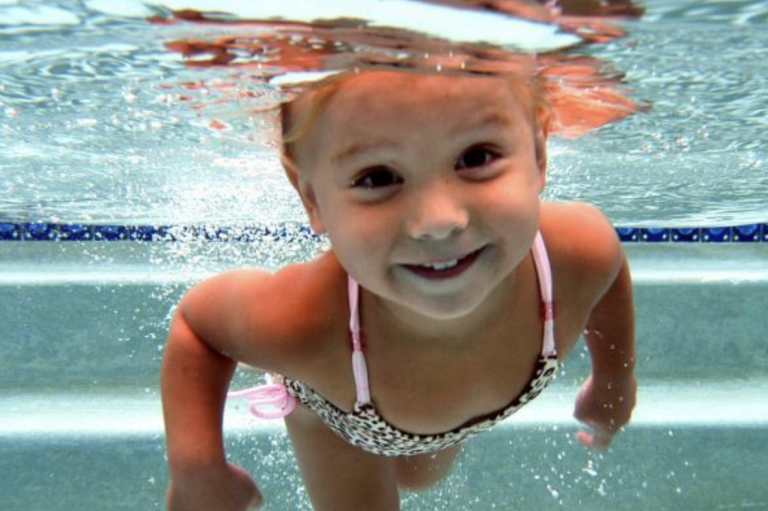ISR swim instruction is for children 6 months to 6 years with all one-on-one instruction. Lessons are conducted 5 days a week (Monday through Friday), at a maximum of 10 minutes a day, for approximately 6 weeks. Each child has their own lesson time daily.
ISR lesson structure
Fully customized, safe and effective, one-on-one instruction
What your child will learn, and the way he or she will learn it, is what makes ISR so different from traditional swimming lessons. Always putting safety first, ISR emphasizes competence, which leads to confidence, and provides the foundation for a lifetime of enjoyment in and around the water.
What your child will learn depends on his or her age and developmental readiness, but in all cases, at minimum, your child will learn to roll onto his or her back to float, rest, and breathe, and to maintain this position until help arrives.
Just 10 minutes a day
Because consistency and repetition are necessary components of learning for infants and young children, ISR students attend a one-on-one, 10-minute lesson daily (same time slot each day), Monday through Friday. You can expect your child to be skilled in an average of 6 weeks. Fewer or additional weeks may be needed depending on your child's needs.
Why 10 minutes? Most of us know infants and toddlers do not spend more that 10 minutes focused on any activity. Research shows that this 10-minute window of learning provides the safest, most effective lesson possible for infants and young children.
Daily consecutive attendance is critical to acquiring ISR Self-Rescue® skills.
ISR lesson in action
Drowning is the leading cause of accidental death for children under the age of 4 in 23 U.S. states. Nationwide, it ranks second only to vehicle accidents. On average, 11 children drown every day. "With ISR training, just because a child wanders to the pool alone doesn't mean he has to die there, and that's our mission," says JoAnn Barnett, Infant Swimming Resource president and CEO.
Skill Sets and Programs
What your child will learn depends on his or her age and developmental readiness, but in all cases, at minimum, your child will learn to roll onto his or her back to float, rest, and breathe, and to maintain this position until help arrives.

ROLLBACK-TO-FLOAT
6 to 15 months
Infants to Early Walkers
The rollback to float program teaches your baby to independently turn themselves onto their back if ever face down in the water to safely breathe, rest, and float on their back until help arrives. This skill set takes about 6 weeks to accomplish.
All students eventually practice their skills wearing a regular diaper, clothing, and shoes, because aquatic accidents can take place anywhere, anytime!

SWIM-FLOAT-SWIM
15 months to 6 years old
Early & Solid Walkers
A child at least 15 months and walking is taught to swim with his face in the water and eyes open. He rolls over onto his back to rest and breathe. He then rotates back onto his stomach to continue swimming towards the edge of the pool and safety.
The Swim-Float-Swim program begins with teaching breath control and the skills to turn around in the water to secure the edge of the pool. Children learn correct swimming posture, movement through the water, the rollback-to-float as well as rotating to a face down position to continue to swim with face in the water and eyes open. This swim-float-swim sequence can be repeated until safety is reached. This skill set takes between 6-8 weeks to accomplish.
All students eventually practice their skills wearing a regular diaper (if not potty-trained), clothing, and shoes, because aquatic accidents can take place anywhere, anytime!

MAINTENANCE LESSONS
After becoming skilled in ISR Self-Rescue®, some parents and their children opt to continue lessons to maintain and practice their skills and simply because they love swimming! It is up to each individual family how they choose to protect their investment. Our recommendation is always twice a month to start if you desire to maintain your child’s skills, OR 1-2 times per week if you’d like to build on your child’s skills. If more are necessary, we can easily add them. If we find twice a month is more than enough, we can always adjust.

REFRESHER LESSONS
In subsequent seasons, it is recommended that students who have not kept up with maintenance lessons or who have hit several developmental milestones, enroll in refresher lessons. Refresher instruction will sharpen and refine skills for each child and reacclimatize them to skills learned when their body was smaller and in a different stage of development. These lessons will also make sure your child is ready for the current summer season. The lessons last 2 weeks, 5 days per week.
Between the ages of five and seven, students often move on to aquatic programs which teach side breathing and the traditional swimming strokes.
A family's ISR journey
A raw, real, and inspiring testimonial. Granger and Amber Smith's son, River, lost his life to drowning in 2019. Three years later, their new baby, Maverick, completed ISR Self-Rescue Lessons.
THERE IS NO SUCH THING AS ‘DROWN-PROOF.’
PLEASE ALWAYS USE PROPER SUPERVISION.
We need your consent to load the translations
We use a third-party service to translate the website content that may collect data about your activity. Please review the details in the privacy policy and accept the service to view the translations.

